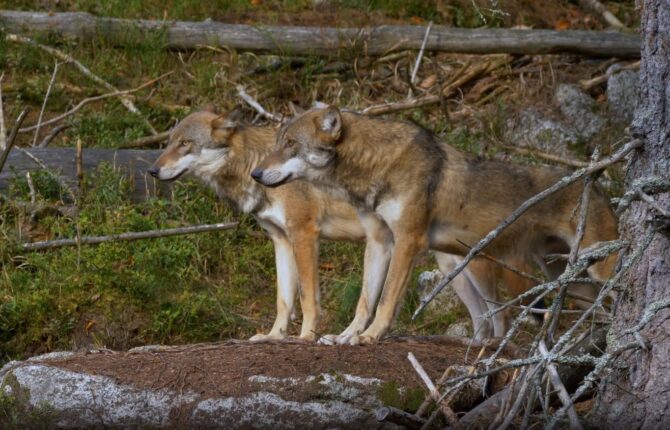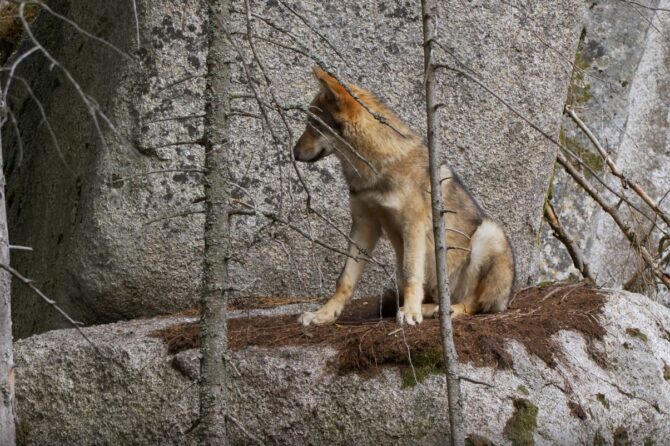Wolves are fascinating creatures that have intrigued humans for centuries with their complex behaviors and advanced sensory abilities. Among their most impressive capabilities is their sense of smell. This article delves deep into the olfactory prowess of wolves, exploring the mechanics of how they smell and the extent of their scent-detecting abilities.
The Science of Smell in Wolves

Wolves rely heavily on their sense of smell to communicate, hunt, and survive in the wild. The wolf’s olfactory system is highly advanced, enabling it to detect a wide range of scents over considerable distances. This sense of smell is facilitated by the wolf’s large nasal chamber, which houses a complex array of receptors that can identify even the faintest odors.
When air enters a wolf’s nose, it passes over these receptors, triggering a signal to the brain. The brain then interprets these signals as specific scents. This process allows wolves to discern a variety of information from the smell alone, including the type of animal, its diet, gender, and even its emotional state.
Anatomical Marvel: The Wolf’s Nose

The wolf’s nose is an anatomical marvel, with adaptations that make it an incredibly sensitive tool for detecting scents. The nasal chamber of a wolf is lined with a mucous membrane that contains a vast network of olfactory receptors. These receptors are much more numerous and sensitive than those of humans, providing wolves with an acute sense of smell.
Additionally, wolves have a Jacobson’s organ, also known as the vomeronasal organ, located at the base of their nasal passage. This organ plays a critical role in detecting pheromones, chemical signals that are essential for communication and reproduction among wolves.
Behavioral Implications of Scent Detection
Wolves utilize their olfactory abilities in various aspects of their behavior, from hunting to social interactions. When hunting, wolves can smell their prey from over a mile away under the right conditions. They use this ability to track animals, following scent trails left behind by their quarry.
In social contexts, wolves use smell to recognize individual members of their pack, establish territories, and communicate through scent marking. Urine and feces are common markers, carrying distinct scents that convey messages about territory, dominance, and reproductive status.
Factors Influencing Scent Detection

Several factors influence how far and well a wolf can smell. Weather conditions, terrain, the scent’s strength, and the wolf’s health and age all play a role. Humidity and wind can carry odors further or disperse them more quickly, affecting a wolf’s ability to detect them. Similarly, the type of terrain can either hinder or help the travel of scent, with open areas typically allowing for better scent distribution than dense forests.
Conservation and Human Interactions
Researching the olfactory capabilities of wolves is crucial for conservation efforts and managing human-wolf interactions. As humans encroach on wolf habitats, it’s essential to understand how human scents affect wolf behavior and movements. For instance, wolves may avoid areas heavily scented with human activity, leading to changes in their natural hunting and migration patterns.
Additionally, conservationists can use knowledge of wolf scent detection in designing protected areas and corridors that take into account the ways wolves use scent to navigate and establish territories.
Exploring the Limits: Range of Wolf Scent Detection

The range at which a wolf can detect a scent is one of the most astonishing aspects of their olfactory abilities. While it is challenging to determine exact distances due to varying environmental conditions, under optimal conditions, it’s believed that wolves can smell their prey from 1 to 2 miles away. However, this range isn’t just a straightforward distance; it’s influenced by the strength of the smell, the wind direction and speed, as well as the humidity and temperature of the environment.
For instance, during cooler periods when the air is denser, scents linger and travel closer to the ground, potentially extending the range at which they can be detected. Conversely, a strong wind might quickly dissipate a scent, making it harder to locate its source. Understanding these nuances is crucial for biologists and conservationists who track wolf movements and behaviors.
The Role of Scent in Pack Dynamics
Within a wolf pack, scent plays a vital role in maintaining social structure and cohesion. Each wolf has its unique scent, allowing members of the pack to identify each other and maintain complex relationships. This olfactory recognition is crucial in establishing hierarchies, identifying members from intruders, and coordinating hunting strategies.
During mating seasons, scent becomes even more critical. Wolves can detect pheromones indicating a potential mate’s fertility and readiness. This ability ensures the continuation of the pack through successful breeding. The olfactory communication facilitated by these scents helps maintain the social and genetic health of the pack.
Challenges in Studying Wolf Olfaction

Despite the extensive knowledge accumulated over the years, studying the olfactory capabilities of wolves presents significant challenges. Observing wolves in their natural habitat without disturbing them or altering their behavior is difficult. Moreover, quantifying scent and its perception is inherently challenging due to the subjective nature of smell and the variability of environmental factors.
Researchers use a combination of field observation, controlled experiments, and technological advancements like GPS tracking and scent collection equipment to overcome these challenges. Despite the difficulties, the continued study of wolf olfaction is essential, providing valuable insights into their behavior, ecology, and evolution.
Human Influences on Wolf Scent Detection
As human activities continue to expand into wild territories, our impact on wolf olfaction and, consequently, their behavior becomes more significant. Pollution, habitat destruction, and even climate change can alter the natural scent landscapes, affecting wolves’ ability to hunt, communicate, and survive.
For instance, pollutants can mask or change the natural scents in an environment, leading to confusion and altered behavior in wolves. Understanding these impacts is crucial for creating effective conservation strategies and ensuring that wolves can continue to thrive in their natural habitats.
FAQs
Can wolves distinguish between different human scents
Yes, wolves can distinguish between different human scents. Each person has a unique odor profile composed of various chemicals, and wolves’ sensitive noses can detect these subtle differences. This ability allows them to discern individuals and may influence their behavior around humans they recognize versus unfamiliar ones.
How do environmental factors like rain affect a wolf’s ability to smell?
Rain can both help and hinder a wolf’s ability to smell. It can intensify odors by dissolving and spreading odor particles, making them easier to detect at close range. However, heavy rain can also wash away scent trails or dilute them, making it more challenging for wolves to track over long distances.
Do wolves have a better sense of smell than dogs?
Wolves generally have a more refined sense of smell than most dog breeds, given their evolutionary adaptations for hunting and survival in the wild. However, some domestic dog breeds, especially those bred for tracking and hunting, may have olfactory capabilities that rival or even exceed those of their wild counterparts.
How does aging affect a wolf’s sense of smell?
As wolves age, their sense of smell may diminish, just like other sensory abilities. This decline can affect their hunting efficiency, social interactions, and overall survival. Elderly wolves may rely more on the pack for food and protection as their sensory acuity decreases.
Can wolves smell fear in humans or other animals?
Wolves can detect pheromones and other chemical signals that may indicate stress or fear in other animals, including humans. While it’s not accurate to say they “smell fear” as a specific scent, they can interpret the combination of smells and hormones that correspond with fear and stress, which may inform their behavior.
Have wolves ever been used in scent detection roles similar to dogs?
Wolves have not been domesticated and trained for scent detection roles to the extent that dogs have, mainly due to their wild nature and the challenges of training them. While their olfactory abilities are remarkable, wolves are typically not considered suitable for roles like search-and-rescue or contraband detection, which are well-suited to certain breeds of dogs.
Final Words
The sense of smell in wolves is a fascinating subject that offers profound insights into these enigmatic creatures. From the basic mechanics of how they detect scents to the complex social behaviors driven by olfaction, every aspect reveals the intricate balance of life in the wild.
As we continue to study and understand these animals, we must also commit to protecting them and the environments they inhabit, ensuring that wolves continue to roam the wilderness, guided by the scents that have shaped their existence for millennia. By appreciating and preserving these aspects of wolf life, we not only enhance our scientific knowledge but also ensure the legacy of these majestic animals for future generations to marvel at and learn from.






